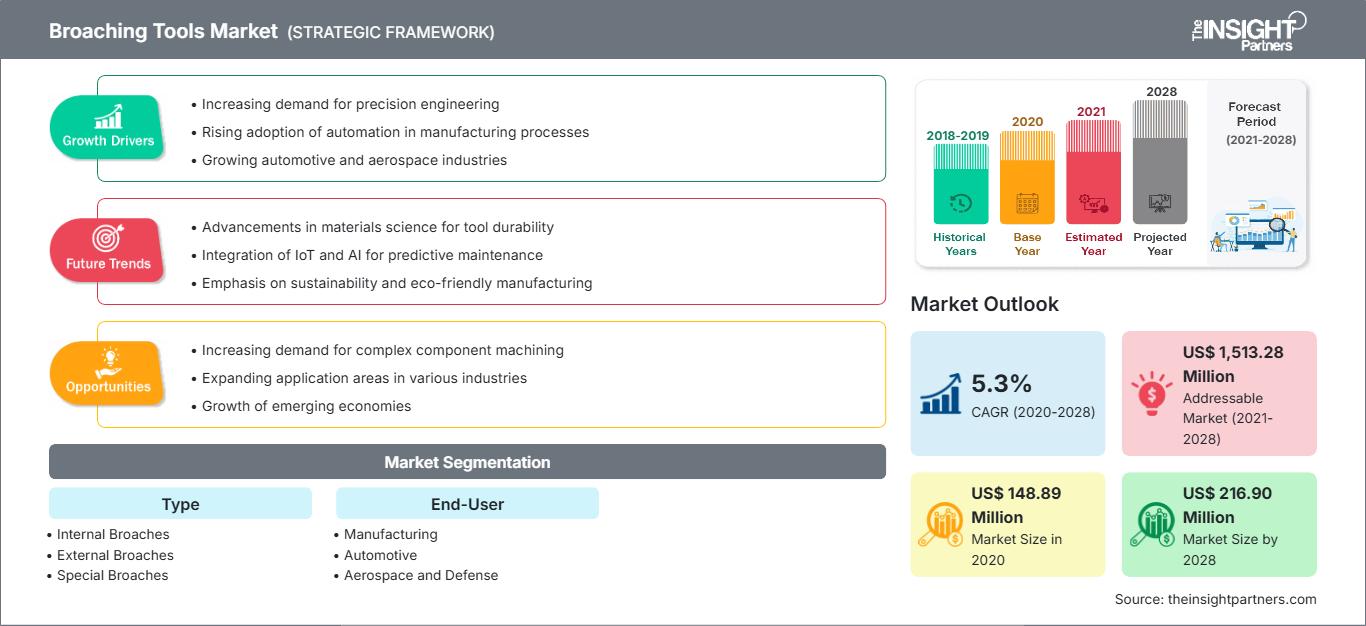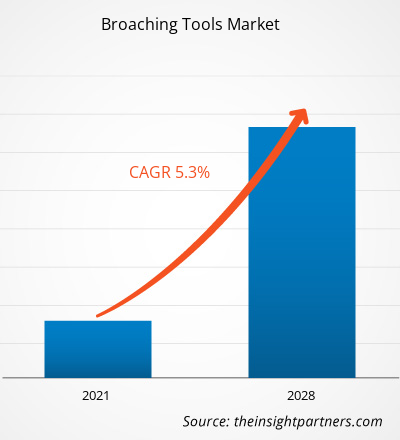The broaching tools market was valued at US$ 148.89 million in 2020 and is projected to reach US$ 216.90 million by 2028; it is expected to grow at a CAGR of 5.3% during 2021–2028.
Owing to the global economic growth, the manufacturing sector has gained significant traction over the last two decades, especially in emerging economies of Asia Pacific. Broaching tools are widely used for producing various industrial components and sub-assembly parts. The rising demand for high speed and accurate finishing process from the end-use sectors such as automotive, aerospace & defense, and construction is encouraging broaching tools manufacturers to introduce advanced tools in the market. The manufacturing sector is one of the key economic growth drivers in APAC. Factors such as low labor cost, increased young population, and government benefits in the form of subsidiaries and tax incentives attract organizations to set up larger manufacturing bases in Asia Pacific. Further, government initiatives such as Made in China 2025 and Make in India are propelling the growth of the manufacturing sector in Asia Pacific. Also, the growing disposable income among the masses is leading to the increasing adoption of the modern lifestyle in the region, which is fueling the demand for consumer electronics and automobiles. This factor is bolstering the manufacturing sector. Therefore, the growing manufacturing sector is driving the growth of the broaching tools market in APAC.
Customize This Report To Suit Your Requirement
You will get customization on any report - free of charge - including parts of this report, or country-level analysis, Excel Data pack, as well as avail great offers and discounts for start-ups & universities
Broaching Tools Market: Strategic Insights

-
Get Top Key Market Trends of this report.This FREE sample will include data analysis, ranging from market trends to estimates and forecasts.
Impact of COVID-19 Pandemic on Broaching Tools Market
The COVID-19 outbreak is adversely affecting the industries worldwide and this devastating effect is continuing in 2021 as well. The outbreak created significant disruptions in primary industries such as manufacturing, healthcare, energy & power, electronics & semiconductor, aerospace & defense, and construction. A significant decline in activities in the mentioned industries is impacting the performance of the broaching tools market negatively. The reimplementation of containment measures such travel restrictions, trade bans, and workforce limitation at workplaces has disrupted the manufacturing, supply, and sales of various businesses, including industrial equipment such as broaching tools.
Broaching Tools Market Insights
Rising Automotive Production
In recent years, there is an increase in demand for high-end automotive, resulting in increased vehicle production, mainly in the developed regions such as North America and Europe. Moreover, the demand for commercial vehicles and passenger cars, primarily in developing nations, is increasing. Broaching tools are widely utilized in automotive sector to manufacture gears, transmission shafts, steering wheel hubs, steering yokes, and others. According to the Center for Automotive Research, a non-profit organization, in 2018, automakers such as FCA, GM, Ford, Hyundai, Nissan, Volkswagen, and Toyota invested US$ 4.8 billion in the automotive industry. In addition, automotive investment in research and development (R&D) has increased by 6.7% to reach US$ 67.09 billion annually in Europe. Thus, rising demand for high-end vehicles and increasing vehicle production is boosting the adoption of broaching tools in the automotive industry.
Type-Based Market Insights
Based on type, the broaching tools market is segmented into internal broaches, external broaches, and special broaches. The internal broaches segment held the largest share in 2020. The market for internal broaches segment is expected grow at the faster rate during the forecast period owing to the increasing demand for vertical broaching machines. The internal broaching technique is widely used for producing various precision components, such as automobile and machinery gears, firearm components, and fasteners. With the steady growth of industrialization across the world, the broaching tools market is expected to witness a significant growth during the forecast period.
The players operating in the broaching tools market focus on strategies such as mergers, acquisitions, and market initiatives to maintain their positions in the market. A few developments by key players are listed below:
- In 2020, the Blohm Jung GmbH launched the PROFIMAT XT with tool changer. The tool enables an automatic change of grinding wheels. This flexible PROFIMAT XT merges four grinding technologies in one machine: reciprocate, creep feed, CD, and speed stroke grinding.
- In 2018, The Blohm Jung GmbH in World Premiere at IMTS launched its new product called PROFIMAT XT. This launch is an expansion of its grinding machine portfolio.
Broaching Tools Market Regional Insights
The regional trends and factors influencing the Broaching Tools Market throughout the forecast period have been thoroughly explained by the analysts at The Insight Partners. This section also discusses Broaching Tools Market segments and geography across North America, Europe, Asia Pacific, Middle East and Africa, and South and Central America.
Broaching Tools Market Report Scope
| Report Attribute | Details |
|---|---|
| Market size in 2020 | US$ 148.89 Million |
| Market Size by 2028 | US$ 216.90 Million |
| Global CAGR (2020 - 2028) | 5.3% |
| Historical Data | 2018-2019 |
| Forecast period | 2021-2028 |
| Segments Covered |
By Type
|
| Regions and Countries Covered |
North America
|
| Market leaders and key company profiles |
|
Broaching Tools Market Players Density: Understanding Its Impact on Business Dynamics
The Broaching Tools Market is growing rapidly, driven by increasing end-user demand due to factors such as evolving consumer preferences, technological advancements, and greater awareness of the product's benefits. As demand rises, businesses are expanding their offerings, innovating to meet consumer needs, and capitalizing on emerging trends, which further fuels market growth.

- Get the Broaching Tools Market top key players overview
The global broaching tools market has been segmented as follows:
Broaching Tools Market – by Type
- Internal Broaches
- External Broaches
- Special Broaches
Broaching Tools Market – by End User
- Manufacturing
- Automotive
- Aerospace & Defence
- Construction
- Others
Broaching Tools Market – by Geography
-
North America
- US
- Canada
- Mexico
-
Europe
- France
- Germany
- Italy
- Russia
- UK
- Rest of Europe
-
Asia Pacific (APAC)
- China
- India
- Japan
- Australia
- South Korea
- Rest of APAC
-
Middle East and Africa (MEA)
- Saudi Arabia
- UAE
- South Africa
- Rest of MEA
-
South America (SAM)
- Brazil
- Argentina
- Rest of SCAM
Company Profiles
- American Broach & Machine Company
- Arthur Klink GmbH
- Colonial Tool Group Inc.
- Ekin S coop
- Blohm Jung GmbH
- Messer Räumtechnik GmbH & Co. KG
- Mitsubishi Heavy Industries Machine Tool Co., Ltd.
- Nachi-Fujikoshi Corp.
- The Broach Masters, Inc.
- Miller Broach
Frequently Asked Questions
Which tool type is expected to dominate the market in the forecast period?
What are reasons behind broaching tools market growth?
What are market opportunities for broaching tools?
- Historical Analysis (2 Years), Base Year, Forecast (7 Years) with CAGR
- PEST and SWOT Analysis
- Market Size Value / Volume - Global, Regional, Country
- Industry and Competitive Landscape
- Excel Dataset
Recent Reports
Testimonials
Reason to Buy
- Informed Decision-Making
- Understanding Market Dynamics
- Competitive Analysis
- Identifying Emerging Markets
- Customer Insights
- Market Forecasts
- Risk Mitigation
- Boosting Operational Efficiency
- Strategic Planning
- Investment Justification
- Tracking Industry Innovations
- Aligning with Regulatory Trends





















 Get Free Sample For
Get Free Sample For